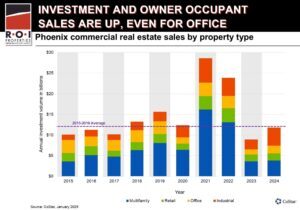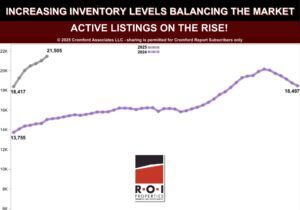In March, we observed as one of our three CRE trends in Greater Phoenix that notices of trustees sales were starting to hit the market, after many months of speculation about inevitable distress. The newest data points from Real Capital Analytics confirm the reasons for concern. US apartment transactions have hit their lowest level since the pandemic: “Nearly 1,040 apartment properties changed hands at a value of $20.6 billion during 1st quarter 2024. The overall sales volume during the quarter was down 25% from 1st quarter 2023, while the number of properties trading hands was down 26% during the same period.”
Obviously, those are national figures, and Phoenix has its own dynamic. In fact, the largest multifamily transaction of the year just closed: Carter, a 365-unit luxury apartment community in downtown Scottsdale, sold for $161.4 million in cash. Our local observations are that properties are selling at a reasonable if slow pace, but at a 19-20% discount from where they were in late 2021 or early 2022, including Class A, B and C properties.
Inflation and Other Pressures on the Multifamily Market
Like all commercial classes, multifamily is also suffering some drag from persistently high interest rates. Higher rates not only increase what investors are paying on loans, they make it more difficult to generate cash flow and overall returns and can exert downward pressure on valuations. The Federal Reserve’s benchmark rate remains at a 23-year high—and the earlier statements of multiple rate decreases now appear overly optimistic, given that we remain well above the Fed’s 2% inflation target.
On a related note, Starwood Real Estate Income Trust recently announced that it would be limiting investors’ monthly withdrawals to 0.33% of net asset value. (The previous limit was 2%.) About 48% of the REIT’s holdings are in market rate apartments—which is part of their reason for a “cash crunch.” In a shareholder letter in May, the company said, “We cannot recommend being an aggressive seller of real estate assets today given what we believe to be a near-bottom market with limited transaction volumes, and our belief that the real estate markets will improve.” More recently, Starwood Capital Group chairman and CEO Barry Sternlicht told CNBC that he expects the restrictions to last about six months—and, while criticizing Fed policy, noted that “The spreads are coming in, which means the markets are healing, the future’s getting clearer.”
Sternlicht also asserted that the move was designed to protect the 80% of investors who have never redeemed shares. Above all, it is an interesting signal that a significant number of investors would be unwilling to stick it out at the current point in time—and it will be instructive to see if other multifamily-heavy REITs follow suit.
Is It Time to Look for Multifamily Opportunities?
For multifamily investors seeking a silver lining, the current environment in the Valley presents an interesting time to buy quality assets—with the knowledge that we are likely not done with distress on the multifamily side. Contact the R.O.I. Properties team to learn more about multifamily investments: [email protected] or 602-319-1326.
Learn More About Our Full-Service Brokerage Firm
Contact Us
View this post on Instagram










